2018 KIA SEDONA brake fluid
[x] Cancel search: brake fluidPage 498 of 586

Maintenance
28
7
Automatic transaxle fluid
Automatic transaxle fluid does not
need to be checked under normal
usage conditions.
But in severe conditions, the fluid
should be changed at an authorized
Kia dealer in accordance to the
scheduled maintenance at the begin-
ning of this chapter.
✽ ✽
NOTICE
Automatic transaxle fluid color is
basically red.
As the vehicle is driven, the auto-
matic transaxle fluid will begin to
look darker.
This a normal condition and you
should not judge the need to replace
the fluid based upon the changed
color.
The use of a non-specified fluid
could result in transaxle malfunction
and failure.
Use only specified automatic
transaxle fluid. (Refer to
“Recommended lubricants and
capacities” in chapter 8.)
Brake hoses and lines
Visually check for proper installation,
chafing, cracks, deterioration and
any leakage. Replace any deteriorat-
ed or damaged parts immediately.
Brake fluid
Check brake fluid level in the brake
fluid reservoir. The level should be
between “MIN” and “MAX” marks on
the side of the reservoir. Use only
hydraulic brake fluid conforming to
DOT 3 or DOT 4 specification.
Parking brake
Inspect the parking brake system
including the parking brake pedal or
lever and cables.
Brake discs, pads, calipers
and rotors
Check the pads for excessive wear,
discs for run out and wear, and
calipers for fluid leakage.
Suspension mounting bolts
Check the suspension connections
for looseness or damage. Retighten
to the specified torque.
Steering gear box, linkage &
boots/lower arm ball joint
With the vehicle stopped and engine
off, check for excessive free-play in
the steering wheel.
Check the linkage for bends or dam-
age. Check the dust boots and ball
joints for deterioration, cracks, or
damage. Replace any damaged
parts.
Page 499 of 586
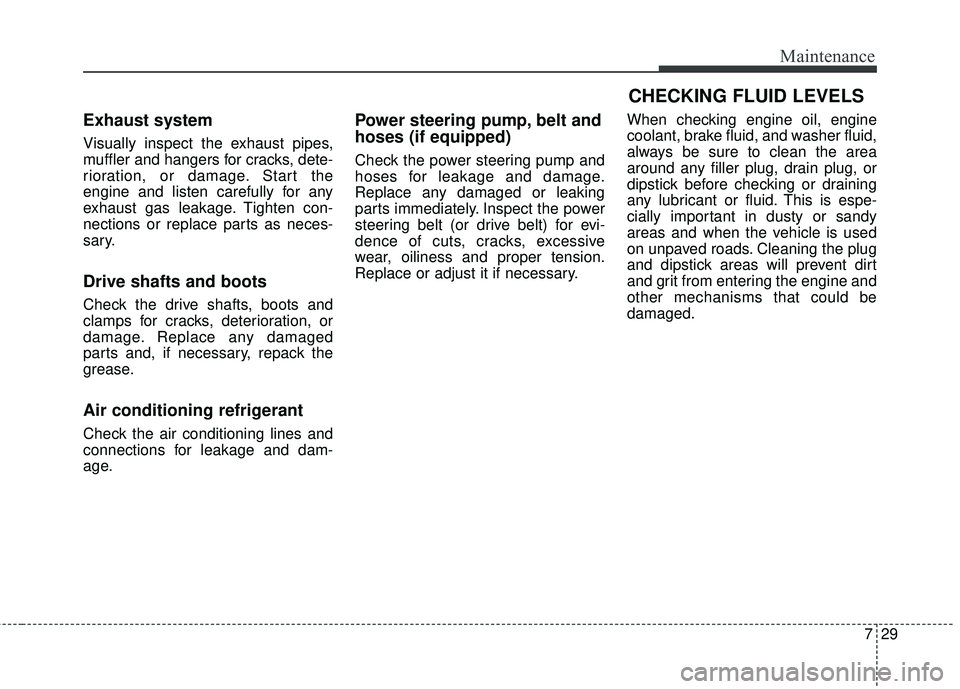
729
Maintenance
Exhaust system
Visually inspect the exhaust pipes,
muffler and hangers for cracks, dete-
rioration, or damage. Start the
engine and listen carefully for any
exhaust gas leakage. Tighten con-
nections or replace parts as neces-
sary.
Drive shafts and boots
Check the drive shafts, boots and
clamps for cracks, deterioration, or
damage. Replace any damaged
parts and, if necessary, repack the
grease.
Air conditioning refrigerant
Check the air conditioning lines and
connections for leakage and dam-
age.
Power steering pump, belt and
hoses (if equipped)
Check the power steering pump and
hoses for leakage and damage.
Replace any damaged or leaking
parts immediately. Inspect the power
steering belt (or drive belt) for evi-
dence of cuts, cracks, excessive
wear, oiliness and proper tension.
Replace or adjust it if necessary.When checking engine oil, engine
coolant, brake fluid, and washer fluid,
always be sure to clean the area
around any filler plug, drain plug, or
dipstick before checking or draining
any lubricant or fluid. This is espe-
cially important in dusty or sandy
areas and when the vehicle is used
on unpaved roads. Cleaning the plug
and dipstick areas will prevent dirt
and grit from entering the engine and
other mechanisms that could be
damaged.
CHECKING FLUID LEVELS
Page 505 of 586
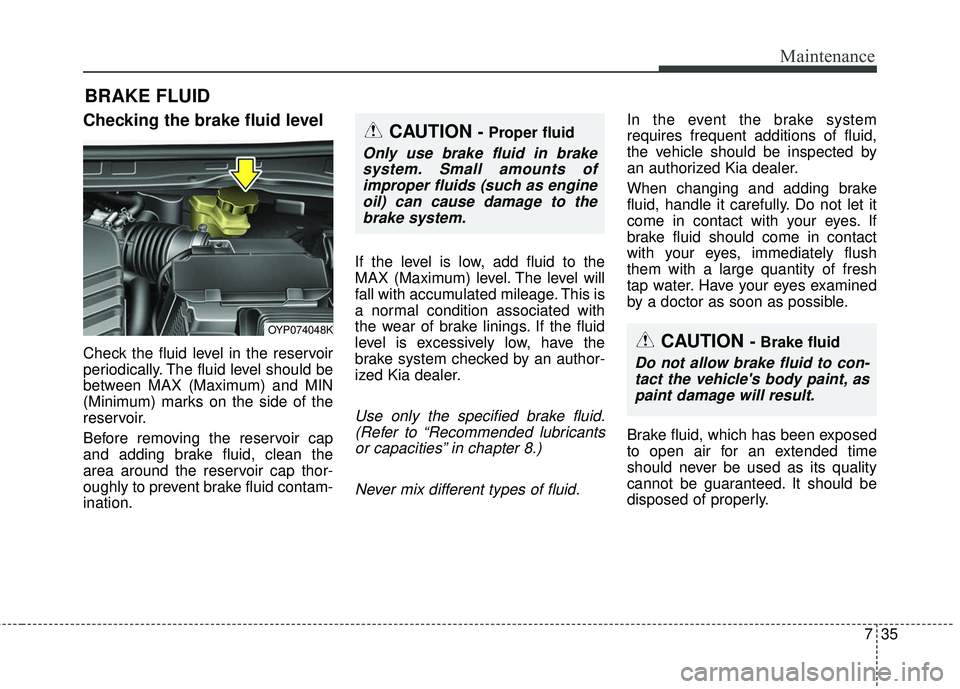
735
Maintenance
BRAKE FLUID
Checking the brake fluid level
Check the fluid level in the reservoir
periodically. The fluid level should be
between MAX (Maximum) and MIN
(Minimum) marks on the side of the
reservoir.
Before removing the reservoir cap
and adding brake fluid, clean the
area around the reservoir cap thor-
oughly to prevent brake fluid contam-
ination.If the level is low, add fluid to the
MAX (Maximum) level. The level will
fall with accumulated mileage. This is
a normal condition associated with
the wear of brake linings. If the fluid
level is excessively low, have the
brake system checked by an author-
ized Kia dealer.
Use only the specified brake fluid.
(Refer to “Recommended lubricantsor capacities” in chapter 8.)
Never mix different types of fluid.
In the event the brake system
requires frequent additions of fluid,
the vehicle should be inspected by
an authorized Kia dealer.
When changing and adding brake
fluid, handle it carefully. Do not let it
come in contact with your eyes. If
brake fluid should come in contact
with your eyes, immediately flush
them with a large quantity of fresh
tap water. Have your eyes examined
by a doctor as soon as possible.
Brake fluid, which has been exposed
to open air for an extended time
should never be used as its quality
cannot be guaranteed. It should be
disposed of properly.
OYP074048K
CAUTION - Proper fluid
Only use brake fluid in brakesystem. Small amounts ofimproper fluids (such as engineoil) can cause damage to thebrake system.
CAUTION - Brake fluid
Do not allow brake fluid to con-tact the vehicle's body paint, aspaint damage will result.
Page 507 of 586
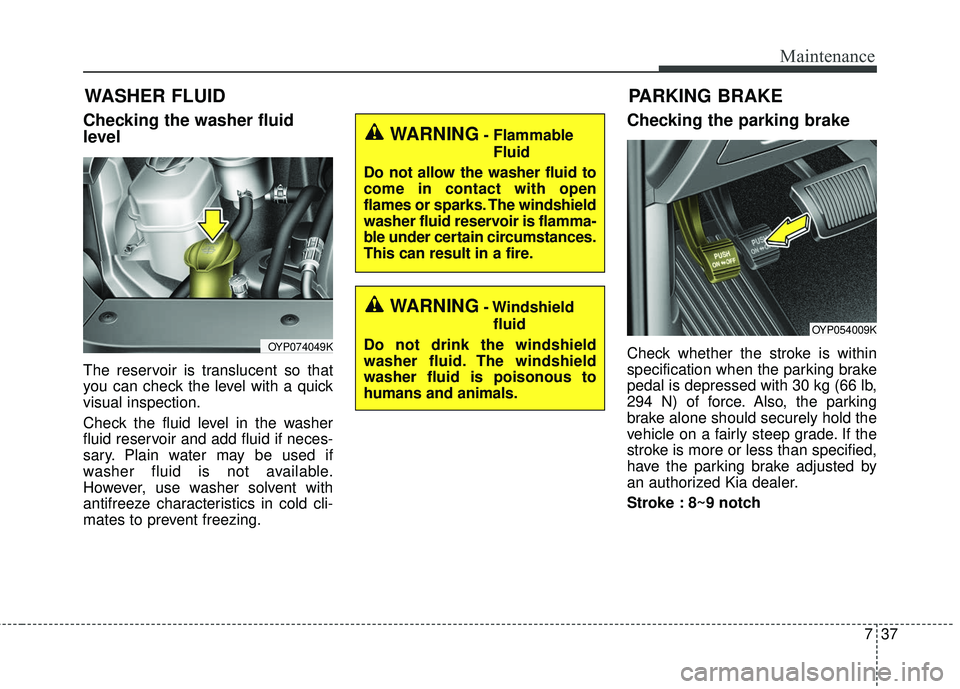
737
Maintenance
WASHER FLUID
Checking the washer fluid
level
The reservoir is translucent so that
you can check the level with a quick
visual inspection.
Check the fluid level in the washer
fluid reservoir and add fluid if neces-
sary. Plain water may be used if
washer fluid is not available.
However, use washer solvent with
antifreeze characteristics in cold cli-
mates to prevent freezing.
Checking the parking brake
Check whether the stroke is within
specification when the parking brake
pedal is depressed with 30 kg (66 lb,
294 N) of force. Also, the parking
brake alone should securely hold the
vehicle on a fairly steep grade. If the
stroke is more or less than specified,
have the parking brake adjusted by
an authorized Kia dealer.
Stroke : 8~9 notchOYP074049K
OYP054009K
PARKING BRAKE
WARNING- FlammableFluid
Do not allow the washer fluid to
come in contact with open
flames or sparks. The windshield
washer fluid reservoir is flamma-
ble under certain circumstances.
This can result in a fire.
WARNING- Windshield fluid
Do not drink the windshield
washer fluid. The windshield
washer fluid is poisonous to
humans and animals.
Page 530 of 586
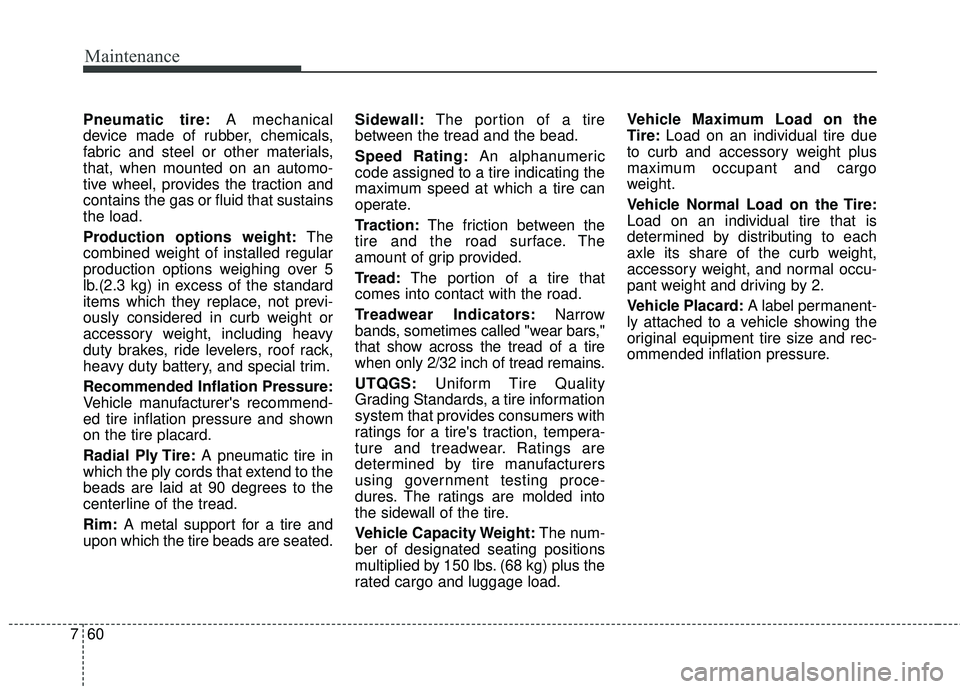
Maintenance
60
7
Pneumatic tire: A mechanical
device made of rubber, chemicals,
fabric and steel or other materials,
that, when mounted on an automo-
tive wheel, provides the traction and
contains the gas or fluid that sustains
the load.
Production options weight: The
combined weight of installed regular
production options weighing over 5
lb.(2.3 kg) in excess of the standard
items which they replace, not previ-
ously considered in curb weight or
accessory weight, including heavy
duty brakes, ride levelers, roof rack,
heavy duty battery, and special trim.
Recommended Inflation Pressure:
Vehicle manufacturer's recommend-
ed tire inflation pressure and shown
on the tire placard.
Radial Ply Tire: A pneumatic tire in
which the ply cords that extend to the
beads are laid at 90 degrees to the
centerline of the tread.
Rim: A metal support for a tire and
upon which the tire beads are seated. Sidewall:
The portion of a tire
between the tread and the bead.
Speed Rating: An alphanumeric
code assigned to a tire indicating the
maximum speed at which a tire can
operate.
Traction: The friction between the
tire and the road surface. The
amount of grip provided.
Tread: The portion of a tire that
comes into contact with the road.
Treadwear Indicators: Narrow
bands, sometimes called "wear bars,"
that show across the tread of a tire
when only 2/32 inch of tread remains.
UTQGS: Uniform Tire Quality
Grading Standards, a tire information
system that provides consumers with
ratings for a tire's traction, tempera-
ture and treadwear. Ratings are
determined by tire manufacturers
using government testing proce-
dures. The ratings are molded into
the sidewall of the tire.
Vehicle Capacity Weight: The num-
ber of designated seating positions
multiplied by 150 lbs. (68 kg) plus the
rated cargo and luggage load. Vehicle Maximum Load on the
Tire:
Load on an individual tire due
to curb and accessory weight plus
maximum occupant and cargo
weight.
Vehicle Normal Load on the Tire:
Load on an individual tire that is
determined by distributing to each
axle its share of the curb weight,
accessory weight, and normal occu-
pant weight and driving by 2.
Vehicle Placard: A label permanent-
ly attached to a vehicle showing the
original equipment tire size and rec-
ommended inflation pressure.
Page 573 of 586
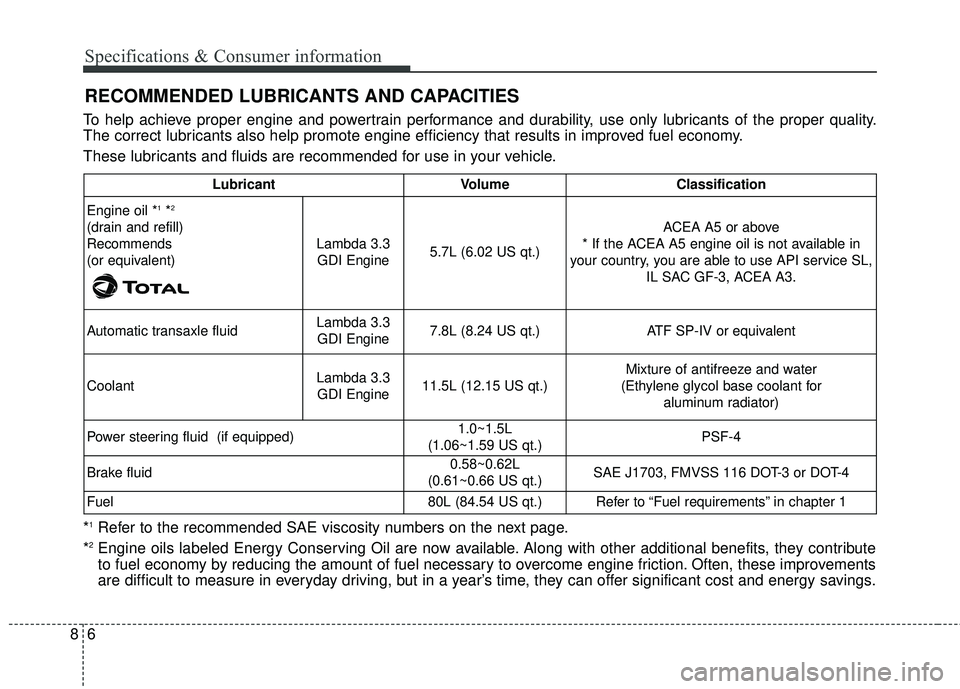
68
Specifications & Consumer information
RECOMMENDED LUBRICANTS AND CAPACITIES
To help achieve proper engine and powertrain performance and durability, use only lubricants of the proper quality.
The correct lubricants also help promote engine efficiency that results in improved fuel economy.
These lubricants and fluids are recommended for use in your vehicle.
*
1Refer to the recommended SAE viscosity numbers on the next page.
*2Engine oils labeled Energy Conserving Oil are now available. Along with other additional benefits, they contribute
to fuel economy by reducing the amount of fuel necessary to overcome engine friction. Often, these improvements
are difficult to measure in everyday driving, but in a year’s time, they can offer significant cost and energy savings.
Lubricant Volume Classification
Engine oil *
1*2
(drain and refill)
Recommends
(or equivalent) Lambda 3.3
GDI Engine 5.7L (6.02 US qt.) ACEA A5 or above
* If the ACEA A5 engine oil is not available in
your country, you are able to use API service SL, IL SAC GF-3, ACEA A3.
Automatic transaxle fluid Lambda 3.3
GDI Engine 7.8L (8.24 US qt.) ATF SP-IV or equivalent
Coolant Lambda 3.3
GDI Engine 11.5L (12.15 US qt.) Mixture of antifreeze and water
(Ethylene glycol base coolant for aluminum radiator)
Power steering fluid (if equipped) 1.0~1.5L
(1.06~1.59 US qt.) PSF-4
Brake fluid 0.58~0.62L
(0.61~0.66 US qt.) SAE J1703, FMVSS 116 DOT-3 or DOT-4
Fuel 80L (84.54 US qt.) Refer to “Fuel requirements” in chapter 1
Page 579 of 586
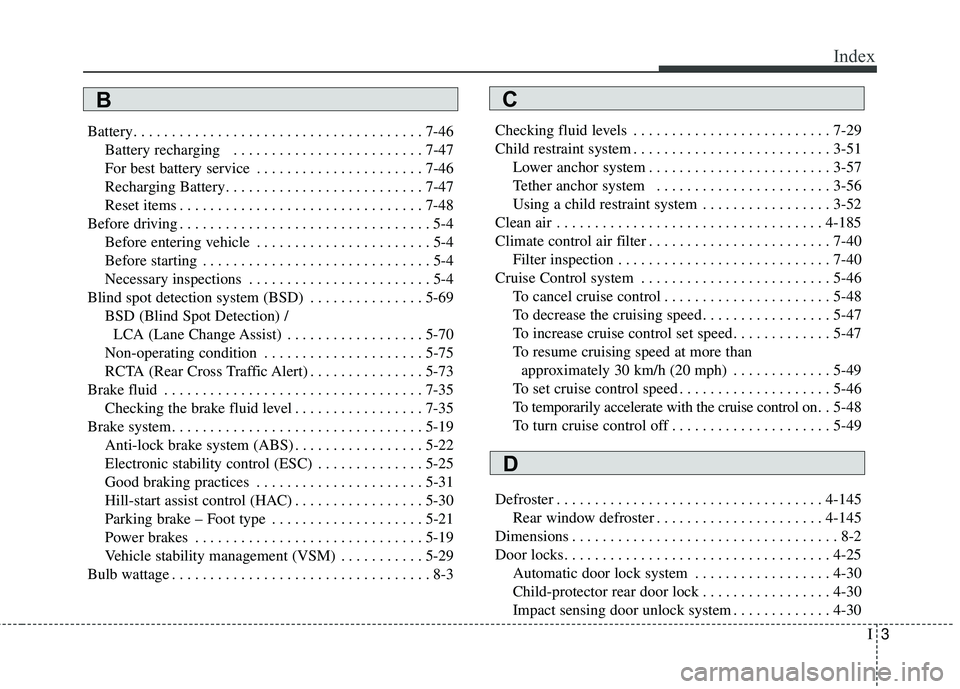
I3
Index
Battery. . . . . . . . . . . . . . . . . . . . . . . . . . . . . . . . . . . . \
. . 7-46Battery recharging . . . . . . . . . . . . . . . . . . . . . . . . . 7-47
For best battery service . . . . . . . . . . . . . . . . . . . . . . 7-46
Recharging Battery. . . . . . . . . . . . . . . . . . . . . . . . . . 7-47
Reset items . . . . . . . . . . . . . . . . . . . . . . . . . . . . . . . . 7-48
Before driving . . . . . . . . . . . . . . . . . . . . . . . . . . . . . . . . . 5-4 Before entering vehicle . . . . . . . . . . . . . . . . . . . . . . . 5-4
Before starting . . . . . . . . . . . . . . . . . . . . . . . . . . . . . . 5-4
Necessary inspections . . . . . . . . . . . . . . . . . . . . . . . . 5-4
Blind spot detection system (BSD) . . . . . . . . . . . . . . . 5-69 BSD (Blind Spot Detection) /LCA (Lane Change Assist) . . . . . . . . . . . . . . . . . . 5-70
Non-operating condition . . . . . . . . . . . . . . . . . . . . . 5-75
RCTA (Rear Cross Traffic Alert) . . . . . . . . . . . . . . . 5-73
Brake fluid . . . . . . . . . . . . . . . . . . . . . . . . . . . . . . . . . . 7-35\
Checking the brake fluid level . . . . . . . . . . . . . . . . . 7-35
Brake system. . . . . . . . . . . . . . . . . . . . . . . . . . . . . . . . . 5-19 Anti-lock brake system (ABS) . . . . . . . . . . . . . . . . . 5-22
Electronic stability control (ESC) . . . . . . . . . . . . . . 5-25
Good braking practices . . . . . . . . . . . . . . . . . . . . . . 5-31
Hill-start assist control (HAC) . . . . . . . . . . . . . . . . . 5-30
Parking brake – Foot type . . . . . . . . . . . . . . . . . . . . 5-21
Power brakes . . . . . . . . . . . . . . . . . . . . . . . . . . . . . . 5-19
Vehicle stability management (VSM) . . . . . . . . . . . 5-29
Bulb wattage . . . . . . . . . . . . . . . . . . . . . . . . . . . . . . . . . . 8-3 Checking fluid levels . . . . . . . . . . . . . . . . . . . . . . . . . . 7-29
Child restraint system . . . . . . . . . . . . . . . . . . . . . . . . . . 3-51
Lower anchor system . . . . . . . . . . . . . . . . . . . . . . . . 3-57
Tether anchor system . . . . . . . . . . . . . . . . . . . . . . . 3-56
Using a child restraint system . . . . . . . . . . . . . . . . . 3-52
Clean air . . . . . . . . . . . . . . . . . . . . . . . . . . . . . . . . . . . 4-\
185
Climate control air filter . . . . . . . . . . . . . . . . . . . . . . . . 7-40 Filter inspection . . . . . . . . . . . . . . . . . . . . . . . . . . . . 7-40
Cruise Control system . . . . . . . . . . . . . . . . . . . . . . . . . 5-46 To cancel cruise control . . . . . . . . . . . . . . . . . . . . . . 5-48
To decrease the cruising speed . . . . . . . . . . . . . . . . . 5-47
To increase cruise control set speed . . . . . . . . . . . . . 5-47
To resume cruising speed at more thanapproximately 30 km/h (20 mph) . . . . . . . . . . . . . 5-49
To set cruise control speed . . . . . . . . . . . . . . . . . . . . 5-46
To temporarily accelerate with the cruise control on. . 5-48
To turn cruise control off . . . . . . . . . . . . . . . . . . . . . 5-49
Defroster . . . . . . . . . . . . . . . . . . . . . . . . . . . . . . . . . . . 4-\
145 Rear window defroster . . . . . . . . . . . . . . . . . . . . . . 4-145
Dimensions . . . . . . . . . . . . . . . . . . . . . . . . . . . . . . . . . . . 8-\
2
Door locks. . . . . . . . . . . . . . . . . . . . . . . . . . . . . . . . . . . 4-\
25 Automatic door lock system . . . . . . . . . . . . . . . . . . 4-30
Child-protector rear door lock . . . . . . . . . . . . . . . . . 4-30
Impact sensing door unlock system . . . . . . . . . . . . . 4-30
CB
D
Page 583 of 586
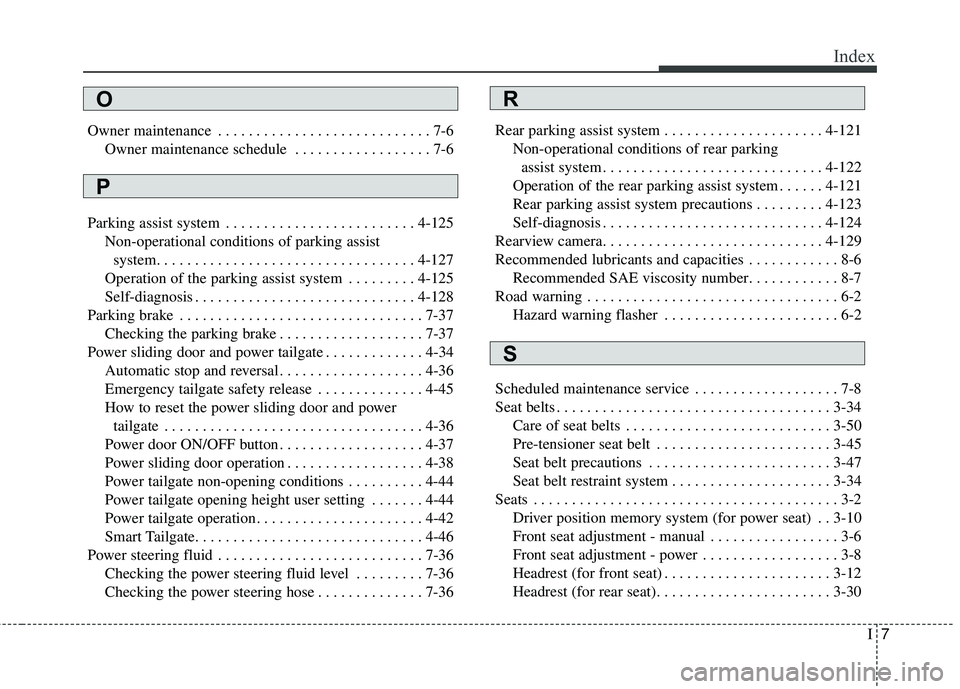
I7
Index
Owner maintenance . . . . . . . . . . . . . . . . . . . . . . . . . . . . 7-6Owner maintenance schedule . . . . . . . . . . . . . . . . . . 7-6
Parking assist system . . . . . . . . . . . . . . . . . . . . . . . . . 4-125 Non-operational conditions of parking assistsystem. . . . . . . . . . . . . . . . . . . . . . . . . . . . . . . . . . 4-12\
7
Operation of the parking assist system . . . . . . . . . 4-125
Self-diagnosis . . . . . . . . . . . . . . . . . . . . . . . . . . . . . 4-128
Parking brake . . . . . . . . . . . . . . . . . . . . . . . . . . . . . . . . 7-37 Checking the parking brake . . . . . . . . . . . . . . . . . . . 7-37
Power sliding door and power tailgate . . . . . . . . . . . . . 4-34 Automatic stop and reversal . . . . . . . . . . . . . . . . . . . 4-36
Emergency tailgate safety release . . . . . . . . . . . . . . 4-45
How to reset the power sliding door and powertailgate . . . . . . . . . . . . . . . . . . . . . . . . . . . . . . . . . . 4-36\
Power door ON/OFF button . . . . . . . . . . . . . . . . . . . 4-37
Power sliding door operation . . . . . . . . . . . . . . . . . . 4-38
Power tailgate non-opening conditions . . . . . . . . . . 4-44
Power tailgate opening height user setting . . . . . . . 4-44
Power tailgate operation . . . . . . . . . . . . . . . . . . . . . . 4-42
Smart Tailgate. . . . . . . . . . . . . . . . . . . . . . . . . . . . . . 4-46
Power steering fluid . . . . . . . . . . . . . . . . . . . . . . . . . . . 7-36 Checking the power steering fluid level . . . . . . . . . 7-36
Checking the power steering hose . . . . . . . . . . . . . . 7-36 Rear parking assist system . . . . . . . . . . . . . . . . . . . . . 4-121
Non-operational conditions of rear parkingassist system . . . . . . . . . . . . . . . . . . . . . . . . . . . . . 4-122
Operation of the rear parking assist system . . . . . . 4-121
Rear parking assist system precautions . . . . . . . . . 4-123
Self-diagnosis . . . . . . . . . . . . . . . . . . . . . . . . . . . . . 4-124
Rearview camera. . . . . . . . . . . . . . . . . . . . . . . . . . . . . 4-129
Recommended lubricants and capacities . . . . . . . . . . . . 8-6 Recommended SAE viscosity number. . . . . . . . . . . . 8-7
Road warning . . . . . . . . . . . . . . . . . . . . . . . . . . . . . . . . . 6-2 Hazard warning flasher . . . . . . . . . . . . . . . . . . . . . . . 6-2
Scheduled maintenance service . . . . . . . . . . . . . . . . . . . 7-8
Seat belts . . . . . . . . . . . . . . . . . . . . . . . . . . . . . . . . . . . . \
3-34 Care of seat belts . . . . . . . . . . . . . . . . . . . . . . . . . . . 3-50
Pre-tensioner seat belt . . . . . . . . . . . . . . . . . . . . . . . 3-45
Seat belt precautions . . . . . . . . . . . . . . . . . . . . . . . . 3-47
Seat belt restraint system . . . . . . . . . . . . . . . . . . . . . 3-34
Seats . . . . . . . . . . . . . . . . . . . . . . . . . . . . . . . . . . . . \
. . . . 3-2 Driver position memory system (for power seat) . . 3-10
Front seat adjustment - manual . . . . . . . . . . . . . . . . . 3-6
Front seat adjustment - power . . . . . . . . . . . . . . . . . . 3-8
Headrest (for front seat) . . . . . . . . . . . . . . . . . . . . . . 3-12
Headrest (for rear seat). . . . . . . . . . . . . . . . . . . . . . . 3-30
O
P
R
S